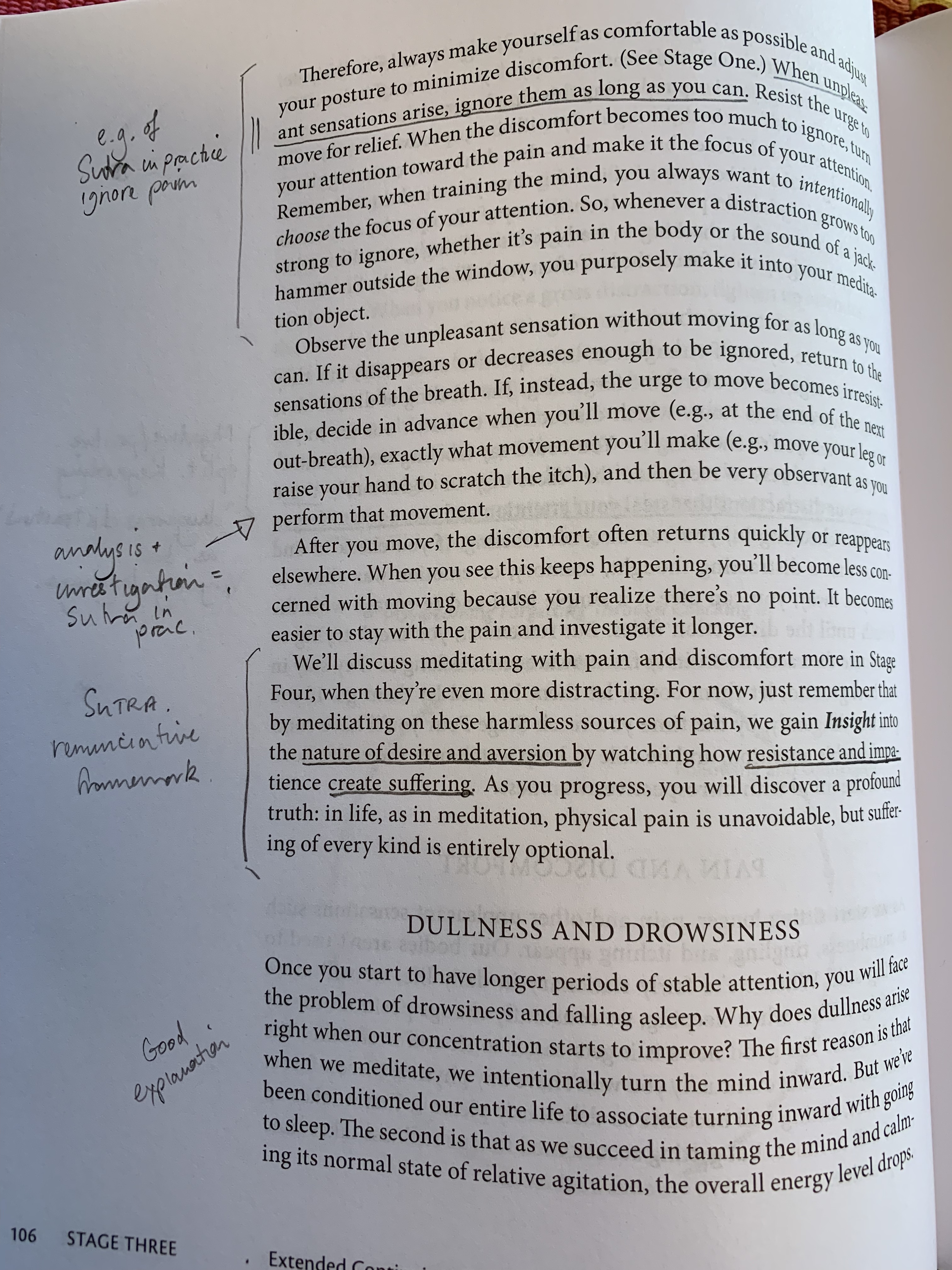
These are reflective notes on my experience of practicing Culadasa’s 10 stage meditation system. The notes in this post are from my sixth day of practice in the system. For an introduction to this project, see this page. Occasionally I will post-edit the journal. Any post editing is [in square brackets like this].
My notes in the margin above on ignoring pain: pain is regarded, and thus worked with, differently in different Buddhist meditation lineages. In Sutric lineages, physical pain reflects human conditioning (the karmic cycle of samsara by which we condition our perception and response), which we are working to overcome. In Vajrayana, pain reflects the human condition (how we find ourselves, the qualities which make us human beings), which we are learning to engage with more skilfully. There are no guarantees in Buddhism historically that our experience will be positive or that our lives will be happy, regardless of our level of accomplishment.
Thus Sutric styled meditation trains endurance with regard to physical pain. In Vajrayana the instruction varies according to lineage. The styles of meditation I have trained with emphasized physical care above all else. The down-side to that is that it can lead to a lot of fidgeting and ‘never quite getting comfortable’.
Anecdotally, the longer you meditate, the more you get used to sitting in your meditation posture and the easier you find it to calibrate when to shift your position, and when not. My Vajrayana-biased personal view is this: if you’re experiencing physical pain to the extent that it permeates your awareness, especially if it is getting worse, stop and deal with it. Try your best not to damage yourself physically through meditation. I have met people who have hurt themselves permanently by ignoring pain. The Vajrayana view is to appreciate our experience, including our bodies.
Day 6
Today I read the chapter on stage 2 of TMI:
“Look for the joy means notice the pleasant aspects of the practice in every moment” (p. 94). Don’t get caught up in negative thoughts and feelings, look instead for the opposite: pleasurable feeling elsewhere.
There is an intentional directed preference for pleasure over pain and for enjoyment over irritation and impatience. The instruction is to nurture feelings of harmony & pleasure and to notice and let go feelings contrary to that aim.
This is quite different to shi-ne practice, in which all sensations, feelings, emotions and thoughts are treated the same way. As forms arising within the spectrum of experience, the technique is not to nurture any of them in favor of any others but remain aware of their arising whilst consciously uninvolved.
I’ll make a point of fully noticing and enjoying the pleasure of meditation and sensations from now on in this practice, whilst letting the less pleasant sensations come and go without involvement.
1 hr sit:
- Calm, focused. Some light thought stories in the background to begin with. They dissipated.
- Face is more relaxed now. Right eyelid up a bit, left one down today.
- It was cold & snowing outside. My skin felt cold. On each in-breath a wave of sensation, starting in the back of the neck, expanded out down my back. Realized I could just make this happen by focusing on the sensation. Did so for a while. It felt a bit manipulative so I let it be & stayed with the breath. Sensation lessened somewhat but was around across my neck & shoulders. Stayed around throughout the day.
45 min sit:
- Followed the stage 2 instruction to regard pleasant sensation positively. This resulted in waves of very pleasant sensations throughout my body for most of the practice.
- Stayed primarily focused on the breath sensations and allowed the pleasurable blissful waves to do their thing. When they subsided slightly, mentally said ‘yes, well done, very good’ and they intensified.
- Checked that this manipulation of the CNS works both ways towards the end of the practice, told the sensations ‘that’s enough now’ and they substantially subsided.
- Then continued with the mild positive regard and allowed the sensation to flow freely. Momentarily experienced a change in sensory experience which was like a pulsating ‘deeper’ sensation inside my head and neck.
